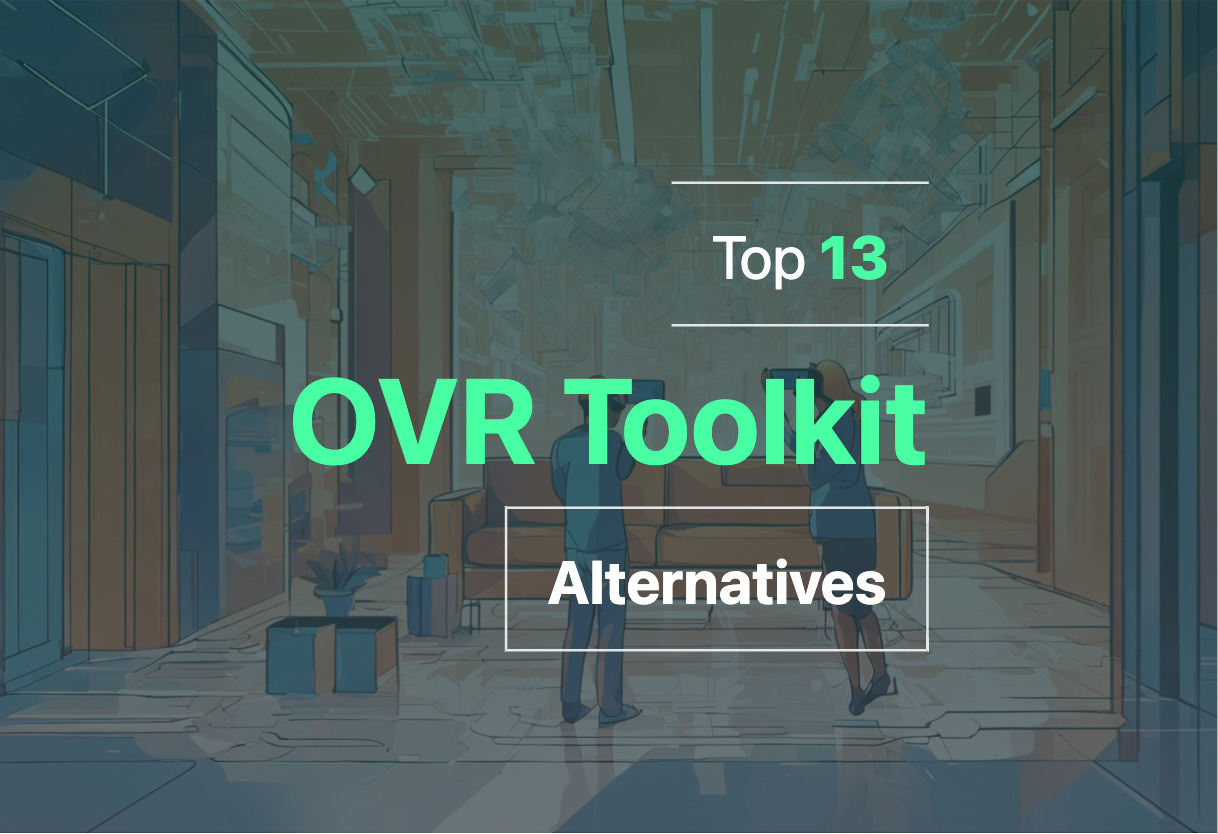
SteamVR

SteamVR is a sophisticated runtime developed by Valve that is designed to power virtual reality experiences. Primarily operating within the Steam ecosystem, it offers a wholesome VR experience with a focus on interactivity, customizability and connectivity.
SteamVR Top Features
- Automatically installs with VR headset connection to PC
- Room setup for defining play area, and device management for firmware update
- Supports launch of apps, connection with friends in VR via SteamVR Home
- In-app purchases handled smoothly using the mirco-transactions API
- Supports creation of overlay applications for extra functionality
| Feature | Description |
|---|---|
| SteamVR Collectibles | 3D Items awarded based on game ownership and playtime |
| Compatibility | Supports its own HMDs and others like Rift |
| CyberShoes | Amplifies immersion by reproducing natural walking movements |
SteamVR Limitations
- Compatibility issues with Meta Quest 3 were reported in mid-2022
- System requirements could be high for some users
SteamVR Use Cases
Use case 1: Immersive Gaming
With the support of 360-degree full room VR experience, SteamVR introduces an immersive level of gaming for the users.
Use case 2: 3D Content Creation
SteamVR supports the creation of 3D environments in PC, making it invaluable for content creators and developers.
Use case 3: Connectivity
SteamVR Home ensures seamless connection with friends for multiplayer VR experiences.
OpenComposite
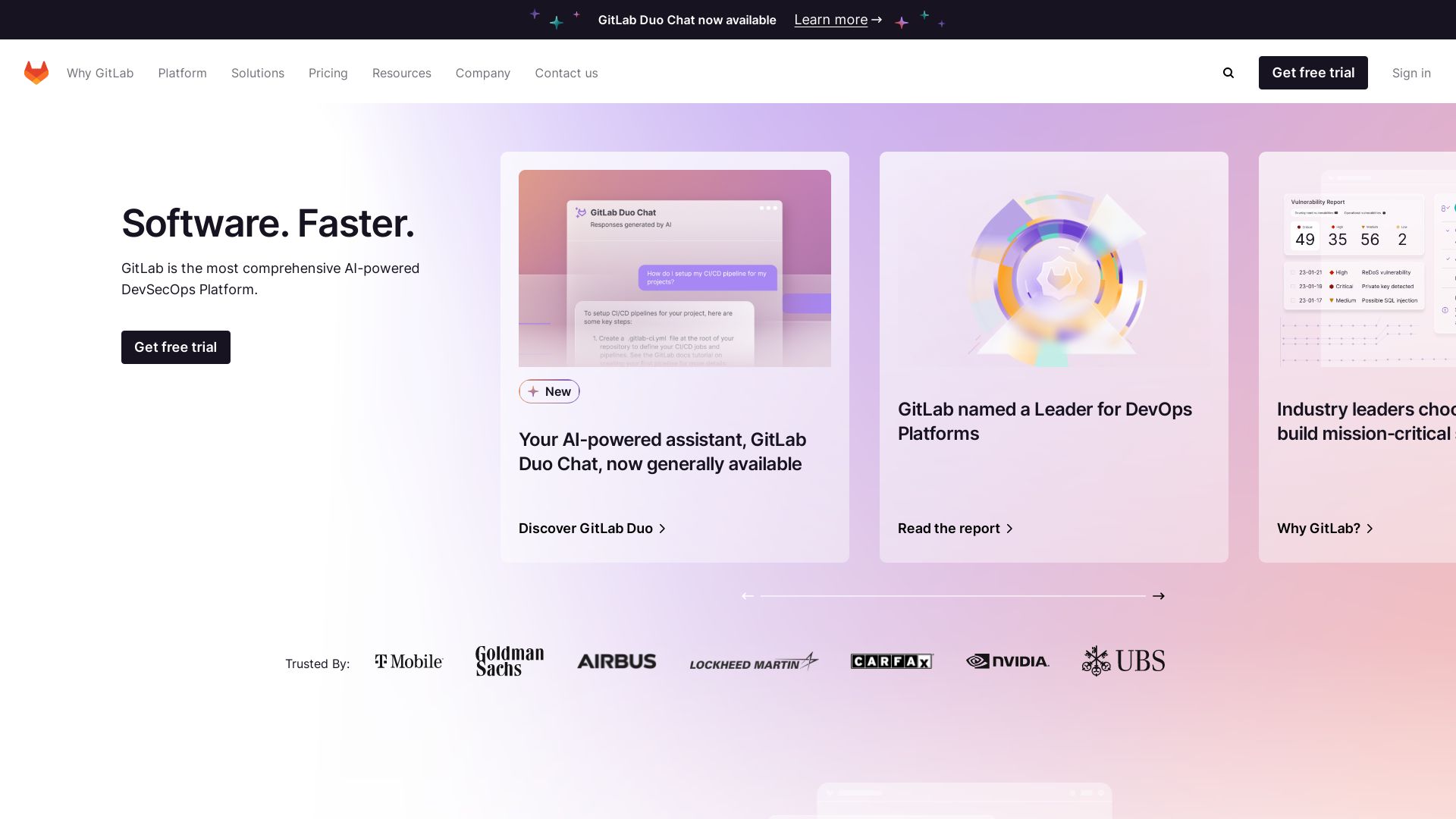
OpenComposite is an OpenXR implementation that serves as an effective alternative to SteamVR by forwarding calls directly to the OpenXR runtime. This results in improved performance, less data consumption and the ability to run an array of existing OpenVR applications without the need for SteamVR.
OpenComposite Key Features
- Data Efficiency: Uses less data compared to SteamVR.
- Performance Improvement: Resolves stuttering issues present in SteamVR, enhancing the smoothness of gameplay.
- Compatibility: Supports various headsets including Windows Mixed Reality, Oculus, Varjo, HTC, and Pico and can run numerous SteamVR games.
| Installation | Available as both system-wide and per-game installation for optimal compatibility. |
| Updates | Easily performable through OpenComposite.exe. |
| Custom Configuration | OpenComposite searches for opencomposite.ini for custom configurations like renderCustomHands, handColour, supersampleRatio etc. |
OpenComposite Limitations
- Limited ability to render controller models.
- Lacks virtual keyboard functionality.
- Compatibility with games is not extensive, although it does support several popular titles.
OpenComposite Pricing
OpenComposite operates under the MIT Licence, thus, it is free and open source.
OpenComposite Use Cases
Use case 1 – High Performance Requirement
For users demanding high performance in VR gaming, OpenComposite offers an alternative to SteamVR by improving gameplay smoothness and reducing data consumption.
Use case 2 – Compatibility Issues with SteamVR
For users facing compatibility problems with SteamVR, OpenComposite can bypass the need for SteamVR altogether.
Use case 3 – OpenVR Applications
OpenComposite provides a platform for users wanting to run existing OpenVR applications without installing SteamVR on their systems.
Quest
Imagine a blend of hi-tech and lightweight in a standalone VR headset, and you’ve got the Quest, a creation of Oculus, the VR child of Facebook, now rebranded as Meta. Released on May 21, 2019, this playful piece of VR gear brings virtual escapades right to your living room, no hefty gaming PC or entangling wires needed. It’s as mainstream as you get in the VR world. Two words: Portable paradise.
Quest Top Features
- Standalone Design: Bids adieu to wires, PCs and phones!
- Loaded with a Qualcomm Snapdragon 835 mobile chipset and dual hand controllers.
- High-Resolution Screen: With 1600 x 1440 pixels per eye, it’s a sight for sore eyes!
- Built-in -wide-angle tracking cameras that lets your digital self dance around with ease.
- Hand-Tracking Support: For those times when you fancy a controller-free VR exploration.
| Redefine gaming with experiences like Beat Saber and The Climb | Automatically swaps between up to five spaces |
| PC Tethering for advanced VR experiences | Upgraded to Snapdragon XR2 processor for Quest 3 model |
| Access to the world’s best library of 500+ immersive VR experiences | Uses the same smooth in-headset menu and store as the original Quest |
Quest Downsides
- A gaming session is cut short with a battery life of just two to three hours.
- Shields only up to 128GB of your digital adventures, unless upgraded at an additional cost.
- Your money feeds the Qualcomm Snapdragon 835, a chipset from 2017.
Quest Pricing
For $399, you get to teleport into your digital universe hassle-free. Fancy an upgrade? The new Meta Quest 3 will welcome you warmly for $499.99 and brings along an array of enhancements.
Quest Use Cases
Use case 1
Into the digital fitness craze? Quest, compatible with games like Beat Saber, offers an intense workout that’s far from being routine (and definitely more fun).
Use case 2
Quest, with its Snapdragon XR2 processor and hand controllers, is a great pick for gamers seeking the thrill of wireless VR gaming.
Use case 3
Forget the 2-D; use applications that let you design in 3-D! The Quest’s high resolution and hand-tracking support are perfect for creators and designers.
Vive
Embark on a journey to high-end VR experiences with Vive, a cutting-edge VR headset crafted by Valve and HTC. To unlock its full potential, hook it up with a VR-ready PC or game console. Live the game beyond pixels with Vive’s high-resolution screens, robust graphics, and motion tracking.
Vive Top Features
- High-Resolution: Equipped with 5K screens, offering a wide field of view at 120 degrees.
- Unique Controllers: Vive comes with specially designed motion controllers for an immersive gaming experience.
- Native Content Library: Gain direct access to HTC Vive’s vast content portfolio.
- Room-Scale Tracking: Allows freedom of movement within a 15 x 15-foot room with a laser tracking system.
- Bonus Games: Pre-orders are accompanied by complementary games.
| Feature | Description |
| HTC Vive Pro 2 | An upgrade option with the highest resolution screen, designed to pair with Valve Index Controllers for max comfort and accurate tracking. |
| Headphones | Vive’s on-ear headphones are included, with the option to be replaced with USB-C headphones. |
| Game Library | Vive offers a large VR game library, including trending titles like Half-Life: Alyx and Beat Saber. |
Vive Limitations
- Cost: It comes with a hefty pre-launch price tag of approximately $799, plus the potential additional cost of a VR-ready PC, typically around $1,000.
- Controllers: The conventional wand-style controllers may feel awkward; pairing with Valve Index Controllers is recommended for a better experience.
Vive Pricing
Aiming for the high-end market, Vive comes with an approximate pre-launch price of $799. Please take into consideration the potential added cost of around $1,000 for a VR-ready PC for the best experience.
Vive Use Cases
Use case 1 – Gaming Enthusiasts
Vive’s advanced specs make it an excellent choice for gaming enthusiasts. With its high-resolution screens, room-scale tracking, and unique controllers, gamers can truly immerse themselves in the VR realm.
Use case 2 – Professional Users
For professionals looking for advanced VR experiences, Vive offers plenty of solutions. From high-end graphics to its native content library, Vive can significantly enhance VR-oriented workflows.
Use case 3 – VR Content Creators
Vive allows content creators to explore, create, and share immersive VR experiences. Its extensive game library offers plenty of inspiration and opportunities for creators.
Windows Mixed Reality
Windows Mixed Reality, a forerunner in Mixed Reality (MR), unifies physical and digital worlds unlocking natural and intuitive interactions. As the next phase in computing, Windows MR transcends traditional screen-bound experiences, delivering immersive experiences through holographic representations and 3D models.
Windows Mixed Reality Top Features
- Mainstream Adoption: MR is massively adopted by consumers and businesses alike.
- Rich Interaction: Advanced interaction with data in living spaces, enriching social media experiences through mobile AR offers.
- Holographic Experiences: Next-level user experiences, leveraging holographic representations of people, 3D models, and the real-world.
- Technological Basis: Key advancements in computer vision, graphical processing, display technologies, input systems, and cloud computing form its foundation.
| Feature | Description |
|---|---|
| Spatial Mapping | Windows MR offers mechanisms like spatial mapping, hand/eye-tracking, spatial sound, enabling realistic experiences. |
| Device Compatibility | Windows Mixed Reality is compatible with numerous conventional laptops and older PCs, targeting the mass market. |
| In-Built Camera | The front-mounted cameras in MR headsets perceive the room and objects, adding these elements to the virtual scene. |
Windows Mixed Reality Limitations
- Limited Devices: Two primary devices for Windows Mixed Reality; Holographic devices and Immersive VR devices.
- Varied Experiences: The user experience can significantly differ depending on the headset brand chosen.
Windows Mixed Reality Use Cases
Use case 1: Gaming
Leveraging Windows Mixed Reality’s advanced features, gamers can achieve deeply immersive experiences with life-like 3D models and rich interactions in their virtual environments.
Use case 2: Education
In the educational sphere, MR allows for interactive and engaging learning experiences through its holographic projection capabilities.
Use case 3: Business
For business enterprises, Windows Mixed Reality can enhance remote collaboration, visualization, and training through MR spaces.
OpenVR
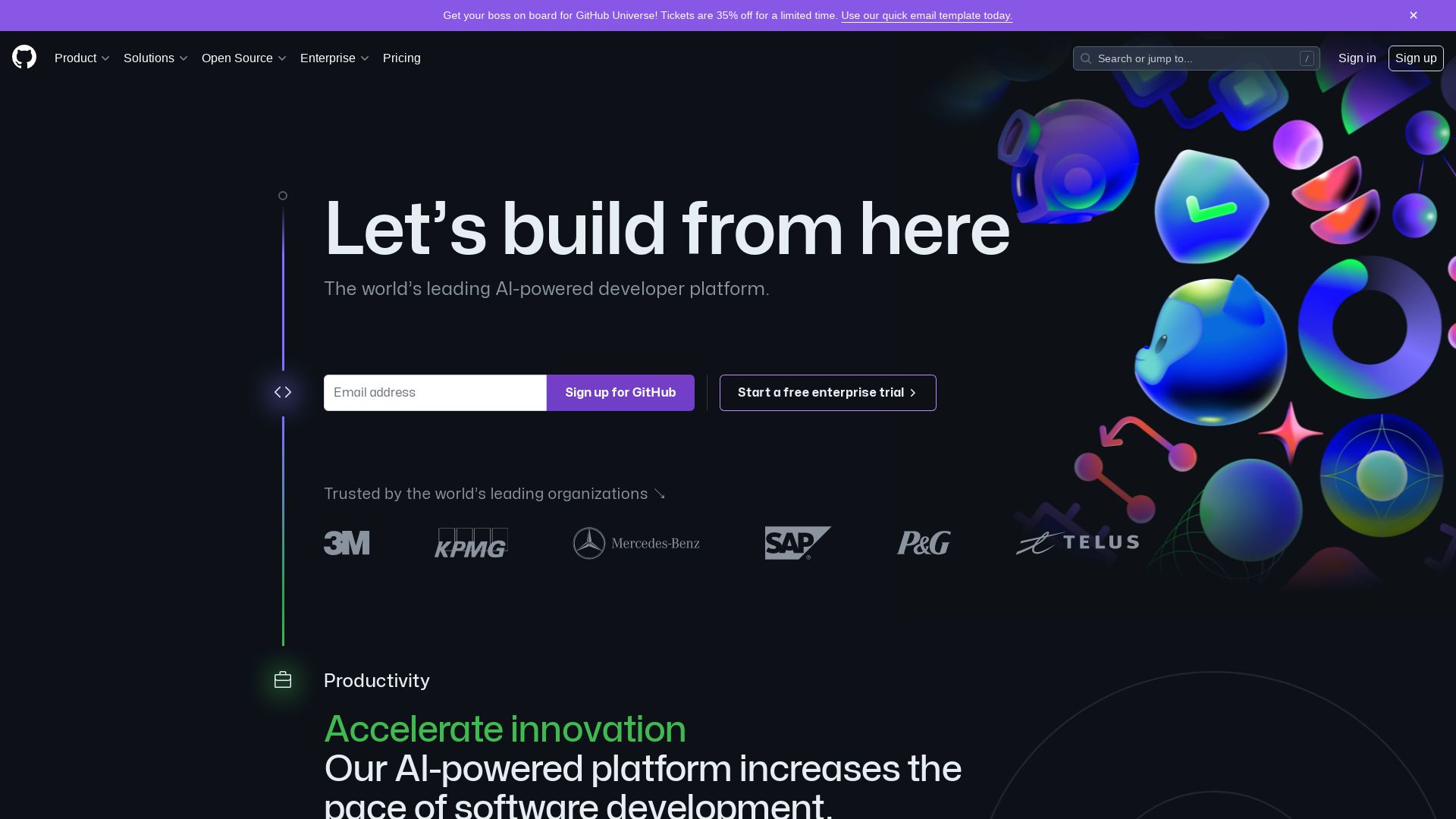
Allow your ideas to take flight in the realm of virtual reality with OpenVR, a prolific software development kit and application programming interface developed by the prodigious masters of the virtual, Valve. OpenVR, ineluctably interwoven with the fabric of leading platforms like SteamVR, has cemented its prowess since its inception on 30 April 2015 and serves as the interface between VR hardware and software.
OpenVR Distinguished Features
- An irreplaceable tool for VR software and game development.
- Brings to the table support for SteamVR hardware, including the HTC Vive Developer Edition.
- The ability to track and reset angular velocity is a testament to its computational innovations.
- Offers flexibility with a plethora of settings and modes, including k_pch_audio_OnRecordDevice_String and k_pch_Camera_EnableCameraForCollisionBounds_Bool, among others.
| Interface | Purpose |
|---|---|
| IVRSystem::ResetSeatedZeroPose | Resets tracking |
| Init(EVRInitError, EVRApplicationType, String) | Initializes VR system |
| Shutdown() | Shuts down VR system |
OpenVR Limitations
- Although it now includes new interfaces, the existing ones have been updated rather than remodeled.
- A noted lack of information regarding the fetching of values and tracking prediction changes.
OpenVR Use Cases
Use case 1
Game developers can harness the power of OpenVR to design immersive experiences. Enabling creative freedom, the SDK allows for the creation of games leveraging haptic feedback and immersive graphical elements.
Use case 2
Educators seeking to innovate their teaching methodology can explore OpenVR to create simulated environments for a range of subjects, from archaeology tours to experiencing physics principles firsthand.
Use case 3
The healthcare sector can leverage this technology to simulate surgeries or visualize patient diagnostics for better treatment insights.
Unity XR
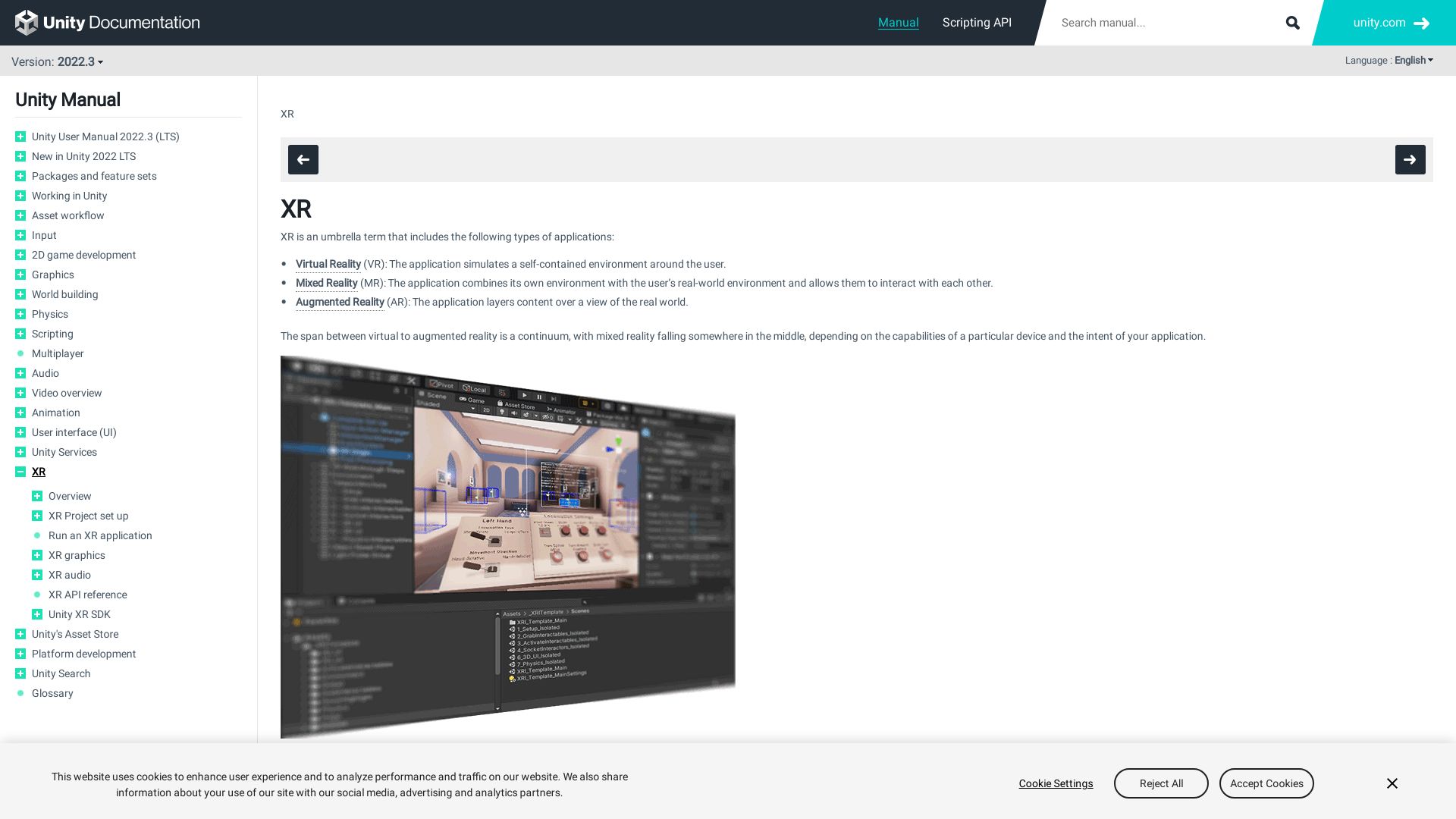
Welcome to the world of Unity XR, a powerhouse that invites immersion into virtual, augmented, and mixed reality. This versatile platform caters to VR, MR and AR developers with supreme ease and agility.
Unity XR Top Features
- Supports XR game/app development by allowing the addition of necessary GameObject and components.
- Hub for headset and device makers to add their hardware support to Unity.
- Hosts repositories on Github for XR Interaction Toolkit and AR Foundation.
- Came up with an upgraded feature, a new unified plug-in framework with Unity 2019.3 for robust cross-platform integration.
- Enables rapid development of XR interactions through the installation of XR Interaction Toolkit (XRIT).
- Presents essential plugins like XR Plugin Management, XR Interaction Toolkit, OpenXR Plugin, Universal RP.
| Course Offering | Examples on Github |
|---|---|
| Conducts upskilling courses to hone skills and achieve career goals | Offers XR Interaction Toolkit Examples to highlight the functions of XRI with example assets and behaviors |
| Weekly classes for building mixed reality, AR, and VR experiences | Provides a fully functional user interaction with XRI through the Complete Set Up prefab |
Unity XR Limitations
Though comprehensive, Unity XR presents a few constraints:
- AR interactions are possible only with the AR Foundation, limiting the scope of AR developers looking for more extensive levels of customization.
- No mention of direct assistance or community support for developers dealing with the complex elements of XR development.
Unity XR Pricing
Unity XR operates on an open-source model, freeing you from the chains of heavy subscription costs. So, embarking on your AR/VR/MR development journey is as light as a feather.
Unity XR Use Cases
Use case 1
Unity XR serves as a boon for AR/VR/MR developers, presenting a platform to develop interactive apps and experiences with reduced coding efforts and maximum efficiency.
Use case 2
For hardware manufacturers, Unity XR facilitates the straightforward integration of their devices, broadening the spectrum of compatibility and boosting market presence.
Use case 3
Educational institutions can leverage Unity XR’s courses to sculpt the next generation of AR/VR/MR wizards, tuning into individual learning objectives and career goals.
Oculus Runtime

Let’s turn the page back to the early saga of VR technology to delve into Oculus Runtime. Transitioning from proprietary developer APIs to OpenXR, Oculus is focusing on a standardized VR/AR application development pathway. Oculus Rift, one of the premier VR headset series, paves the way with their affordable yet realistic VR experience.
Oculus Runtime Top Features
- OpenXR standard: Replacing Oculus Mobile and Oculus PC SDK.
- Full Interoperability: Supported by numerous VR industry companies.
- Ongoing Support for Older Apps: Previous applications on Oculus SDKs will continue to function, yet new features will be delivered only via OpenXR extensions.
- Oculus Rift: Positioned as a revolutionary VR headset, offering a realistic VR experience at an accessible price.
| Hardware Requirements | Oculus Rift Models |
|---|---|
| Intel Core i3-6100 or AMD FX 4350, GeForce GTX 960, 2 USB 3.0 ports, 1 USB 2.0 port, Windows 8 or newer | Oculus Rift DK1 and Oculus Rift S (discontinued in 2021) |
Oculus Runtime Limitations
- Unity’s OpenXR Support: Still experimental, with full support expected only by 2022.
- Unreal Engine’s OpenXR Support: Expected to coincide with the version 5 release in 2022.
- Motion Sickness: A common complaint among users, limiting prolonged usage.
Oculus Runtime Use Cases
Oculus Runtime in Architecture
The Oculus Runtime allows architects to visualize and design structures in a virtual environment. It enriches conceptualization and improves design accuracies.
Oculus Runtime in Automobile Industry
Companies like Audi leverage Oculus Runtime to configure and experiment with new design structures. By presenting a virtual model, engineers can conduct precise, risk-free experiments.
Oculus Runtime in Education
Schools and universities use Oculus Runtime as an immersive learning tool. It supplies a deeper understanding of subjects, enhancing students’ academic performances.
Virtual Desktop
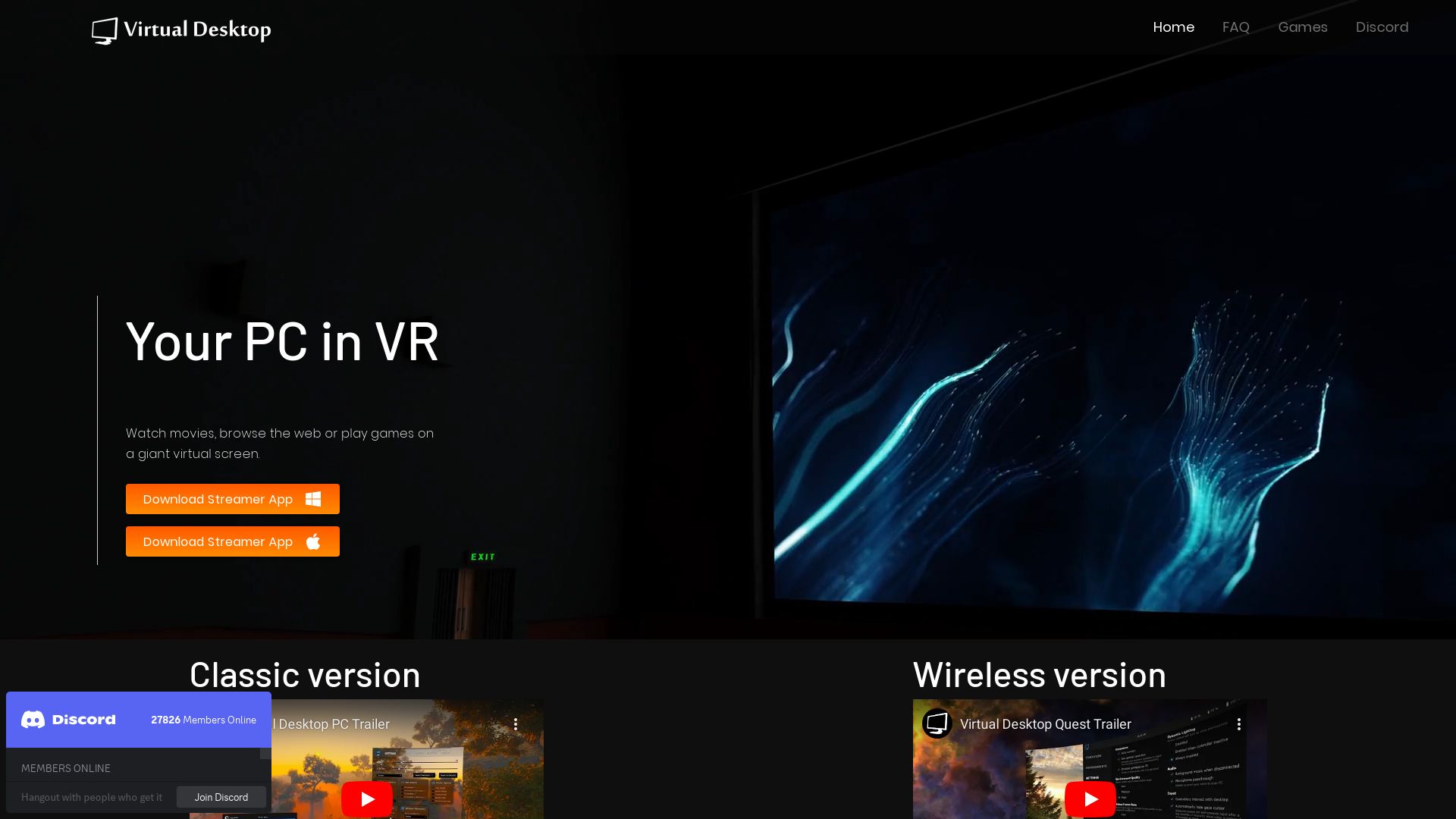
As a cutting edge solution for immersive computing, Virtual Desktop empowers users to seamlessly operate SteamVR and Oculus Rift games on VR ready PCs. Built for Windows 10 and 11, this dynamic tool redefines the boundaries of virtual interaction and productivity.
Virtual Desktop Top Features
- Operates PCVR games and other applications in a VR environment.
- Enables access to productivity tools such as Microsoft Office in VR through Oculus
- Provides secure streaming experience with microphone passthrough and gamepad emulation capabilities.
- Offers a resizable virtual desktop, facilitating multitasking and enhancing productivity.
- Sustained efficiency for both gaming and work purposes.
| Installation Setup | Enabled for Windows 10 or 11, with firewall and antivirus compatibility needs. |
| Hardware Compatibilities | Fully compatible with Oculus Rift, HTC Vive, and seamlessly collaborates with Meta Quest hardware. |
| Streaming Abilities | Packs features supporting 3D SBS movies, 360 photos, and videos with optimized latency for high-quality streaming. |
Virtual Desktop Limitations
- Does not support Mac for gaming functionalities.
- Requires LAN connection for optimal streaming experience.
- Specific antivirus software may need disabling or exception-adding for Virtual Desktop Streamer.
- Some elements of the tool, like viewing main desktop, can appear stretched with lower resolution.
Virtual Desktop Pricing
Virtual Desktop is available as a paid tool across multiple platforms. Platforms include Oculus Store, Itch.io, or Patreon. However, the tool does not offer a ‘free-to-play’ option but is refundable through Steam.
Virtual Desktop Use Cases
Use case 1: Boosting Entertainment
Brush off the limitations of physical screens and enter a realm of unlimited display space. Stream your favourite PCVR games, watch Netflix on a giant virtual screen, and enjoy movies and web browsing with ease and immersion.
Use case 2: Remote Working
One Amazon user reported a remarkable 3255 hours of productive use, a testament to the tool’s effectiveness for remote work outfits. Utilize Microsoft Office, photo editing software, or any work-related app like you normally would, but in an immersive VR environment.
Use case 3: Content Creation
For creators and designers, the ability to use graphic-intensive apps as though they were natively in VR is an immense boost. Create, edit, and prototype without leaving the VR environment.
Oculus
Acknowledged for mainstreaming VR, Oculus started its journey with Oculus Rift, the first VR headset spearheading a realistic VR experience at an affordable price. Imagine this coming from an industry that emerged back in the 1830s with Sir Charles Wheatstone’s early stereoscope.
Top Oculus Features
- Unique geometrical pre-distortion and large stereoscopic field of view introduced in 2011 by Oculus Rift prototype.
- 3D stereoscopic view of 90 degrees horizontal and 110 degrees vertical, reducing the screen door effect.
- Oculus Rift CV1 (2016) – first Oculus model for public use, offering an unprecedented VR experience.
- Oculus Rift S, an upgrade of Oculus Rift CV1, integrated with software library of its preceder.
| Feature | Description |
|---|---|
| Drift-free Head Tracking | Equipped with three-axis gyros, accelerometers, and magnetometers for seamless tracking of head movements. |
| “Crystal Cove” Prototype | Offered low-persistence of vision, revealing advancement in clarity and reduced screen door effect. |
| Field Of View (FOV) | Exceeding 90 degrees in horizontal orientation, it offers twice the FOV of previous VR devices. |
Oculus Limitations
- Discontinuation of Oculus Rift line in April 2021 marking the end of one of the industry’s most iconic VR headset lines.
- VR industry’s challenges including comfort and support, evidenced by the market failure of Nintendo Virtual Boy console.
Oculus Use Cases
Use Case 1 – Gaming
With strong roots in gaming, Oculus offers an immersive experience in 3D and beyond, transporting you into the heart of the game.
Use Case 2 – Education
Oculus is not simply for gamers, it holds enormous potential in revolutionizing education – Imagine learning history by virtually living in that era.
Use Case 3 – Business
Businesses can utilize Oculus for virtual meetings, training simulations or product demonstrations, bringing an entirely new dimension to corporate communication and marketing.
Oculus VR
Oculus VR, known today as Meta, is a trailblazer in the realm of virtual reality. Founded by Palmer Luckey and later bought by Facebook, it has revolutionized the VR world with its innovative products like the Rift VR headset and the Meta Quest series. The company, initially mobilized by a successful Kickstarter campaign, rose to fame and continues to redefine the future with its ambitious vision for the metaverse.
Oculus VR Top Features
- Powerhouse behind the groundbreaking Rift VR headset and the versatile Meta Quest series.
- Standing alone in offering high performance at an affordable price point.
- Unique partnership with Samsung led to the creation of the specialized Gear VR in 2015.
| Product | Feature |
|---|---|
| Meta Quest 2 | High power, customizable, and affordable VR headset. |
| Meta Quest Pro | Professional-level VR headset with advanced features. |
Oculus VR Limitations
- Company under significant resource strain, with Meta’s Reality Labs division facing mounting losses.
- Potential future competition from Apple’s as yet unreleased Vision Pro mixed-reality headset.
- Brand continuity challenges followed the company’s rebranding to Meta and the consequent conclusion of the Oculus brand.
Oculus VR Pricing
Each Oculus product has different pricing, based on its specifications and features. It’s worth noting that Oculus VR has maintained a reputation for combining high performance with affordability.
Oculus VR Use Cases
Use case 1 – Gaming
Utilizing the tremendous power and adaptable design of Oculus VR devices, gamers can engage in a truly immersive and realistic gaming experience.
Use case 2 – Professional training
Industries from healthcare to the military are harnessing Oculus VR technology for specialized training purposes, simulating real-world scenarios for improved learning.
Use case 3 – Virtual social interaction
Oculus VR’s vision of the metaverse opens up infinite possibilities for virtual social interactions, making physical distances irrelevant in the realm of communication.
Quest 2
The Quest 2 is a high-quality VR headset, developed by Reality Labs, a division of Meta Platforms. Initially launched as Oculus Quest 2, it was rebranded to Meta Quest 2 in 2022 and has become a staple in virtual reality since its release on October 13, 2020.
Quest 2 Top Features
- Runs on an Android-based Quest system software, current version Android 12.1
- Powers up with a Qualcomm Snapdragon XR2 processor
- Boasts of a memory capacity of 6 GB LPDDR4X.
- Offers internal storage options of 128 GB and 256 GB
- Projects through an RGB LCD of 1832 x 1920 per eye resolution at refresh rates of 72-120 Hz
- Produces sound via two built-in speakers and accommodates an additional 3.5mm headphone jack
- Performs seamless 6DOF inside-out tracking via four inbuilt cameras and two controllers
- Equipped with various connectivity options including USB-C, Bluetooth 5, and Wi-Fi 6
- Provides an ever-growing library of games and experiences via the Quest Store
| Weight | 503 g (17.7 oz) |
| Design | The design is lighter with updated specs and a higher refresh rate, improved Oculus Touch controllers for a better gaming experience. |
| Standalone | PC-Based | Works standalone on the internal OS, or syncs with Oculus Rift-compatible VR software on a desktop computer. |
Quest 2 Limitations
- Battery life can be short, lasting only between 2-3 hours between charges
- While the original 64GB storage was expanded to a standard 128GB, it still lacks room for further expansion
- The controller, even though improved, could still benefit from more refinement for better hand tracking.
Quest 2 Pricing
Depending on your storage requirements, the Quest 2 is priced at $299 for the 64GB (discontinued), $399 for the 256GB variant.
Quest 2 Use Cases
Gaming Purposes
With its updated specificities and high refresh rate, the Quest 2 offers an immersive gaming experience like no other in the market. The vast library of VR games hosted on the Quest Store adds to its appeal.
Virtual Reality Experiences
Quest 2’s high definition display and inside-out tracking capabilities provide an unparalleled VR experience, making it perfect for individuals looking for realistic interactive experiences or educational purposes.
Professional Use
With its top-of-the-line specs and PC compatibility, the Quest 2 serves wonderfully in professional settings, offering a wide array of applications in fields like architecture, healthcare, and training programs.
Oculus 2
Stepping into the future with an upgraded device comes the Oculus Quest 2, an affordable standalone VR headset developed by Meta. Packed with robust processors and a stellar screen, this upgraded gadget takes you on a journey into immersive worlds untouched by reality.
Oculus 2 Top|Best Features
- Processor: Empowered with the Snapdragon XR2 processor, a robust improvement on Snapdragon 835 chip in the original model.
- Storage: Increased to a standard of 128GB from the initial 64GB. A 256GB model is available for those who crave more space, with no expansion capability.
- Display: Adopting a 1,920 by 1,832-pixel high-resolution display per eye, a noticeable enhancement from Quest 1’s 1,600 by 1,440 pixels.
- Connectivity: A standalone unit compatible with PC. With an optional $79 Link Cable, you can bridge the gap between you and Rift’s tethered headsets as Meta transitions away.
- Compatibility: Ensemble with Android and operates wirelessly. Break free from the restraints and explore new landscapes.
| Feature | Description |
|---|---|
| Tracking | 4 wide-angle cameras providing 6DOF with hand, desk, couch, and keyboard tracking |
| Weight | At just 1.1 pounds, delivering a mobile VR experience is a breeze |
| Additional Features | Hand-tracking, Oculus Link & Air Link, Fitness tracking, Bluetooth mouse & keyboard support, voice controls |
Oculus 2 Downsides
- Mandatory Facebook account aligning with Facebook-associated privacy issues.
- No storage expansion capability despite varying storage options.
- Overall battery life stretches to only 2-3 hours, requiring a $129 add-on battery pack for extended use.
Oculus 2 Pricing
Currently priced at $299, the Oculus Quest 2 stands as a budget-friendly VR headset. Higher pricing for increased storage or accessory options may apply.
Oculus 2 Use Cases
Gaming
Equipped with Oculus Touch Controllers, immerse yourself in a wide array of VR games and experiences. With access to Steam games via the tethering option, your gaming adventures are limitless.
Social Interaction
Connected to the Facebook platform, engage socially with friends for gameplay. Navigate Oculus’ in-built browser or Firefox Reality for a dynamic digital network environment.
Hands-Free Activities
Supports voice controls and unique features for hand-free options. Manage your world without the need to touch, perfect for your indoor fitness routine.
Logan Bellbrook
Content writer @ Aircada with a knack for nature & AR/VR/XR. Blogging the intersection of tech & terrain.




